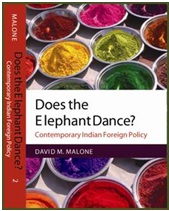
David Malone, President of the International Development Research Centre (IDRC) in Canada, recently published a volume titled Does the Elephant Dance? Contemporary Indian Foreign Policy. In this extensive account, Malone catalogues the key aspects that affect India’s foreign policy: its history, domestic politics, security challenges, economic factors, and regional relations, to name the most important.
In Malone’s view, many aspects of Indian foreign policy can be understood as a function of three key factors: history, geography, and capabilities. India’s history–the legacies of the spread of religions in the sub-continent, its geographic environment, and of different regimes and empires–permeates many aspects of Indian politics, including foreign policy.
Geography is the second key determinant. Malone highlights India’s troubled relationships with many of its neighbors in the region, noting that Pakistan, while worrisome, is not the key concern. Instead, a lot of India’s concerns are aimed at China.
Finally, Malone describes India’s remarkable economic development as a key factor influencing its growing “game-changing” capabilities. The high growth now typical of the Indian economy is still a fairly recent development, and was triggered by the far-reaching reforms that liberalized the Indian economy following the balance-of-payments crisis in 1990-91.
In conclusion, Malone identifies three main leitmotifs of Indian foreign policy. The first is its quest for autonomy–it is perennially difficult to make India an ally. The second is strategic restraint, a kind of prudence in all of its actions. Finally, the overarching priority is economic prosperity and progress, which trumps other concerns.




